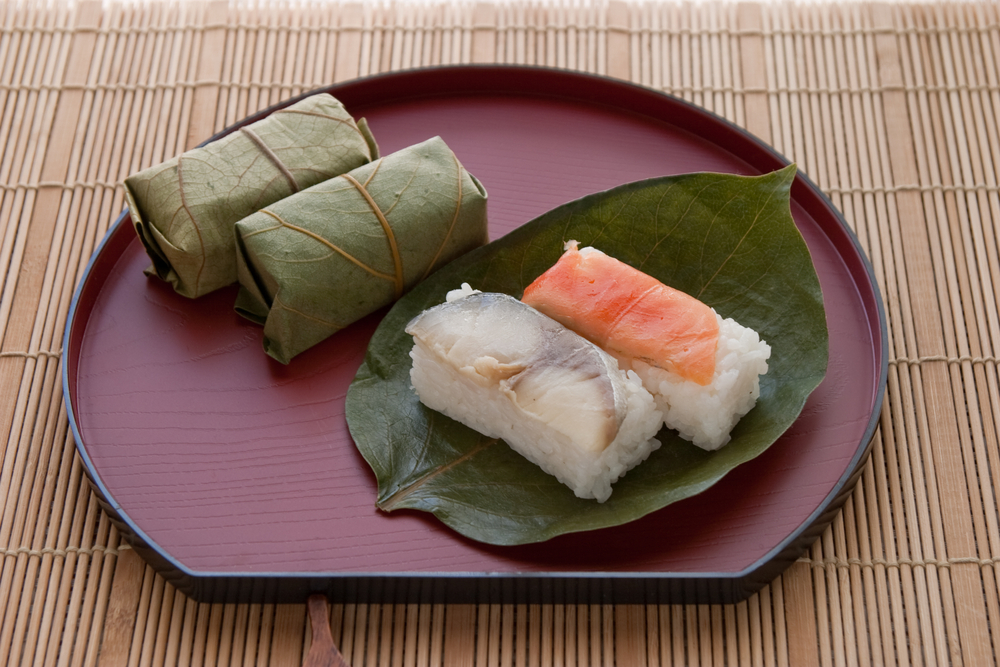Sushi wrapped in kakinoha is a traditional Japanese dish that’s been delighting taste buds for centuries. It is mainly eaten in Nara and Wakayama prefectures, and is popular as a local souvenir. But what makes this culinary creation so special? In this article, we explore the history and ingredients of sushi wrapped in kakinoha, as well as its unique flavor, cultural significance, and nutritional benefits. Read on to learn all about one of Japan’s most beloved dishes!
Contents
History of Sushi Wrapped in Kakinoha
Sushi wrapped in kakinoha is a traditional Japanese dish that has been around for centuries. It is believed to have originated during the Edo Period (1603-1868) when sushi was first invented. It is generally wrapped in persimmon leaves, but in some areas it is wrapped in kelp. Persimmon leaf sushi was devised to be easy to carry and store without spoiling the taste and texture. This practice made the sushi easier to transport and store without compromising its taste or texture.
Kakinoha sushi contains a variety of ingredients, such as cooked white rice mixed with vinegar, fish. The ingredients are placed on top of the kakinoha strips and then rolled up into a cylindrical shape. The rolls are then tied together using string. Finally, they are cut into slices and served as individual pieces.
Kakinoha sushi is beloved by many Japanese people as it is a convenient and delicious way to enjoy traditional Japanese flavors on the go. It also has excellent nutritional benefits due to the combination of ingredients used in its making. For example, the rice provides carbohydrates for energy while the fish provides essential proteins and fats for health and well-being.

How Sushi Wrapped in Kakinoha is Made
When making sushi wrapped in kakinoha, the first step is to prepare the ingredients. This usually involves cooking short-grain Japanese rice and then mixing it with a blend of rice vinegar, sugar, and salt. The type of filling used for sushi wrapped in kakinoha can vary but commonly includes fish. Once the ingredients are prepared, the sushi is wrapped in strips of kakinoha (bamboo leaves). The bamboo leaves give the sushi a unique flavor and fragrance.
The next step is to wrap the ingredients. This involves taking a strip of bamboo leaf and folding it into two layers around the filling. The edges are then twisted together so that they form an envelope shape. Finally, the envelope is tied off with twine or string to hold it together firmly.
Why Sushi Wrapped in Kakinoha is so Beloved in Japan
Sushi wrapped in kakinoha has become a beloved dish among the people of Japan due to its unique and delicious flavors. The bamboo leaves used to wrap the sushi, known as kakinoha, add an earthy flavor and provide great texture contrasts that make this type of sushi stand out from other types. Additionally, the combination of different ingredients contained within the roll provides many layers of flavor that tantalize the taste buds.
The inclusion of fish in sushi wrapped in kakinoha adds a richness of umami but also a subtle sweetness that helps balance out the other flavors. Most commonly, types such as salmon and mackerel are used as well as some regional varieties like sea bream depending on where you are eating it. Furthermore, when combined with pickled vegetables or nori seaweed sheets, sushi wrapped in kakinoha can be a very healthy and nutritious dish.
Nutritional Benefits of Sushi Wrapped in Kakinoha
Sushi wrapped in kakinoha is a nutritious and delicious dish that is popular in Japan. The main ingredients used to make this dish are sushi rice, fish, and bamboo leaves. The combination of the different flavors from the rice, fish, and bamboo leaves creates a unique texture and taste to the sushi.
The fish used for sushi wrapped in kakinoha can be anything from salmon to mackerel. This provides an array of vitamins and minerals such as omega-3 fatty acids, calcium, iron, zinc, and magnesium. Sushi wrapped in kakinoha is also very low in fat and calories which makes it a great healthy option for those watching their weight or trying to maintain a balanced diet.
In addition to its nutritional benefits, sushi wrapped in kakinoha also has several health benefits due to its high protein content. Protein helps build muscle mass and aids with digestion while also keeping us full longer than other foods.
Eating sushi wrapped in kakinoha is not only savory but beneficial for your overall health too! So next time you’re craving something tasty yet nutritious try some delicious sushi wrapped in kakinoha! When visiting Nara or Wakayama prefectures, be sure to try sushi wrapped in kakinoha.
Conclusion
Sushi wrapped in kakinoha is a popular Japanese dish that has been enjoyed for centuries. It is made by wrapping sushi in kakinoha (bamboo leaves) and usually contains ingredients such as rice, fish. This dish is known for its unique flavors and textures, as well as its potential health benefits like its high protein content and low calorie count. Sushi wrapped in kakinoha is a delicious and nutritious way to enjoy traditional Japanese cuisine.
Sushi wrapped in kakinoha is a beloved Japanese dish that has been enjoyed by people all over the country for centuries. It is made with fresh ingredients, including sushi rice and a variety of different fillings, and then carefully wrapped in bamboo leaves to create a unique flavor and texture. Not only does it taste delicious, but it also offers a range of nutritional benefits, such as its high protein content and low calorie count. Whether you’re looking for an interesting dinner option or just trying something new, sushi wrapped in kakinoha is an excellent choice to try. With its delectable flavors and health benefits, this dish is sure to be a hit with everyone who tries it!
